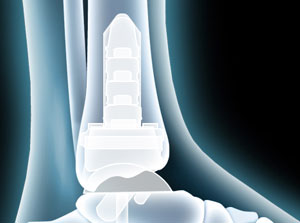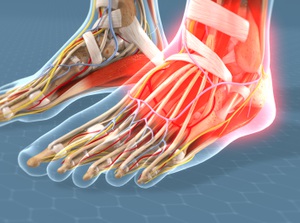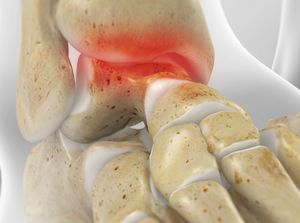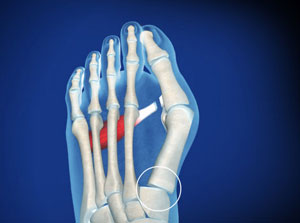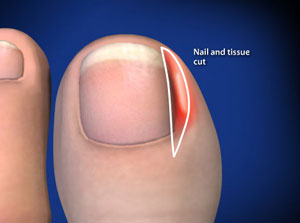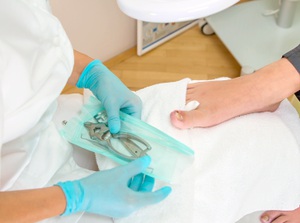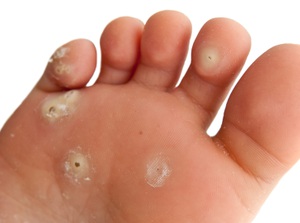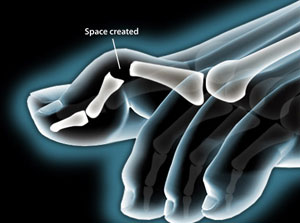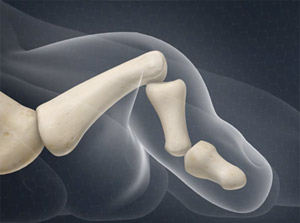Educational Videos
Ankle
Care and Management
Arthroscopic Articular Cartilage Repair (Ankle)
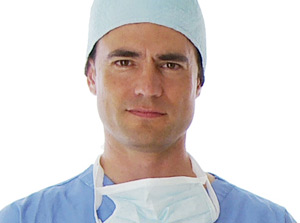 This minimally-invasive procedure is performed to stimulate the growth of fibrocartilage in an injured joint. Fibrocartilage is a tough, dense, fibrous material that can fill in areas where smooth, glassy cartilage has become damaged or worn away. This procedure may be performed with general or regional anesthesia.
This minimally-invasive procedure is performed to stimulate the growth of fibrocartilage in an injured joint. Fibrocartilage is a tough, dense, fibrous material that can fill in areas where smooth, glassy cartilage has become damaged or worn away. This procedure may be performed with general or regional anesthesia.
Lateral Ankle Ligament Reconstruction (ALR)
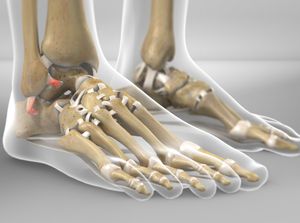 This surgery corrects an unstable ankle. It tightens one or more ligaments that support your ankle. It helps people who've had repeated ankle sprains. It can also help people who have certain foot deformities.
This surgery corrects an unstable ankle. It tightens one or more ligaments that support your ankle. It helps people who've had repeated ankle sprains. It can also help people who have certain foot deformities.
Radiofrequency Treatment for Achilles Tendinosis (TOPAZ® Coblation®)
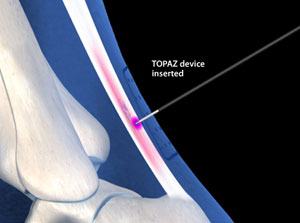 During this procedure, the surgeon uses a specialized radiofrequency instrument to break up scar tissue in a painfully-inflamed Achilles tendon. The coblation procedure can be performed as a minimally-invasive procedure through the skin, or it can be performed as part of an open surgical procedure. This animation will show the minimally-invasive technique.
During this procedure, the surgeon uses a specialized radiofrequency instrument to break up scar tissue in a painfully-inflamed Achilles tendon. The coblation procedure can be performed as a minimally-invasive procedure through the skin, or it can be performed as part of an open surgical procedure. This animation will show the minimally-invasive technique.
Conditions
Ankle Sprains
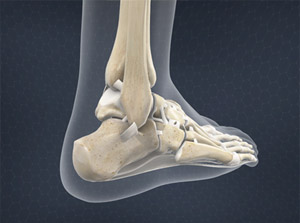 Ligaments are fibrous, elastic bands of tissue that connect and stabilize the bones. An ankle sprain is a common, painful injury that occurs when one or more of the ankle ligaments is stretched beyond the normal range of motion. Sprains can occur as a result of sudden twisting, turning or rolling movements.
Ligaments are fibrous, elastic bands of tissue that connect and stabilize the bones. An ankle sprain is a common, painful injury that occurs when one or more of the ankle ligaments is stretched beyond the normal range of motion. Sprains can occur as a result of sudden twisting, turning or rolling movements.
Big Toe
Care and Management
First Metatarsal-phalangeal (MTP) Total Joint Replacement (MOVEMENT™)
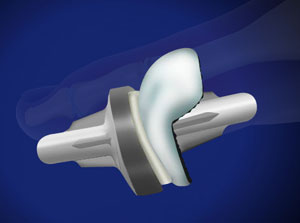 This procedure uses a small, two-piece implant to cover damaged or missing articular cartilage in the MTP joint, where the base of the great toe meets the foot. The implant restores mobility to the bones of this joint, allowing them to glide smoothly against each other. This procedure is commonly used to treat hallux rigidus, also called stiff big toe.
This procedure uses a small, two-piece implant to cover damaged or missing articular cartilage in the MTP joint, where the base of the great toe meets the foot. The implant restores mobility to the bones of this joint, allowing them to glide smoothly against each other. This procedure is commonly used to treat hallux rigidus, also called stiff big toe.
First Metatarsal-phalangeal Joint (MTP) Arthrodesis
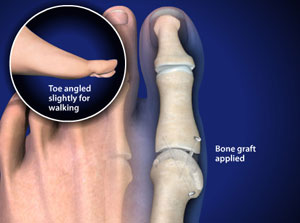 This surgical procedure is performed to help relieve pain in the front of the foot and correct deformities in the MTP joint of the big toe caused by injury, arthritis or genetic defect. The procedure fuses the bone at the base of the big toe to the first metatarsal bone of the foot.
This surgical procedure is performed to help relieve pain in the front of the foot and correct deformities in the MTP joint of the big toe caused by injury, arthritis or genetic defect. The procedure fuses the bone at the base of the big toe to the first metatarsal bone of the foot.
Conditions
Bunion
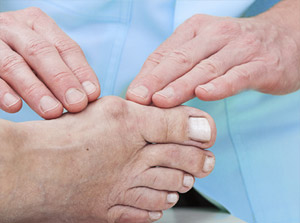 This deformity affects the joint at the base of the big toe. It is a bony bump beneath the skin on the inner side of the foot. A bunion starts small, but over time it can grow to become very large. Bunions are more common in women.
This deformity affects the joint at the base of the big toe. It is a bony bump beneath the skin on the inner side of the foot. A bunion starts small, but over time it can grow to become very large. Bunions are more common in women.
Hallux Rigidus (Stiff Big Toe)
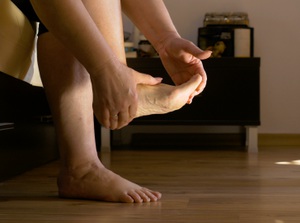 This is a type of arthritis that affects the base of the big toe. It forms in the metatarsophalangeal joint (we call it the "MTP" joint). With hallux rigidus, the protective cartilage on the ends of these bones wears away. Bone rubs against bone. Bony growths called "bone spurs" may form. Your toe stiffens, and this can make walking uncomfortable.
This is a type of arthritis that affects the base of the big toe. It forms in the metatarsophalangeal joint (we call it the "MTP" joint). With hallux rigidus, the protective cartilage on the ends of these bones wears away. Bone rubs against bone. Bony growths called "bone spurs" may form. Your toe stiffens, and this can make walking uncomfortable.
Foot
Care and Management
Radiofrequency Treatment for Plantar Fasciitis (TOPAZ® Coblation®)
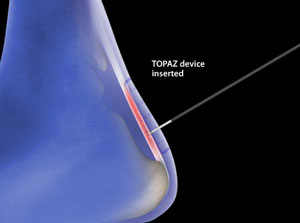 During this procedure, the surgeon uses a radiofrequency device called a TOPAZ microdebrider to break up scar tissue in a painfully-inflamed plantar fascia (a band of tissue at the bottom of the foot). The coblation procedure can be performed as a minimally-invasive procedure through the skin, or it can be performed as part of an open surgical procedure. This animation will show the minimally-invasive technique.
During this procedure, the surgeon uses a radiofrequency device called a TOPAZ microdebrider to break up scar tissue in a painfully-inflamed plantar fascia (a band of tissue at the bottom of the foot). The coblation procedure can be performed as a minimally-invasive procedure through the skin, or it can be performed as part of an open surgical procedure. This animation will show the minimally-invasive technique.
Conditions
Morton's Neuroma
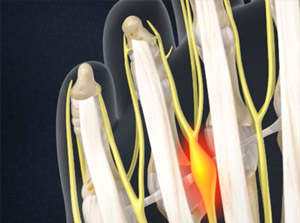 This condition is a thickening of the nerve sheath that surrounds a nerve in the ball of the foot. It most commonly develops between the third and fourth toes. It also commonly occurs between the second and third toes.
This condition is a thickening of the nerve sheath that surrounds a nerve in the ball of the foot. It most commonly develops between the third and fourth toes. It also commonly occurs between the second and third toes.
Plantar Fasciitis
 Plantar fasciitis is an irritation of the plantar fascia. This thick band of connective tissue travels across the bottom of the foot between the toes and the heel. It supports the foot's natural arch. It stretches and becomes taut whenever the foot bears weight.
Plantar fasciitis is an irritation of the plantar fascia. This thick band of connective tissue travels across the bottom of the foot between the toes and the heel. It supports the foot's natural arch. It stretches and becomes taut whenever the foot bears weight.
Posterior Tibial Tendon Dysfunction (PTTD)
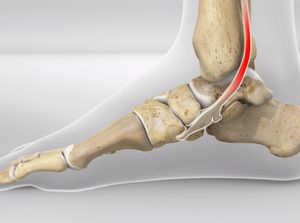 This is a problem with a tendon supporting the foot's arch. We call it the posterior tibial tendon. It connects the calf muscle to the bones on the inner side of the foot. With posterior tibial tendon dysfunction, the tendon becomes inflamed or torn. Your arch becomes unstable, and it may collapse.
This is a problem with a tendon supporting the foot's arch. We call it the posterior tibial tendon. It connects the calf muscle to the bones on the inner side of the foot. With posterior tibial tendon dysfunction, the tendon becomes inflamed or torn. Your arch becomes unstable, and it may collapse.
General
Heel
Lesser Toes
Care and Management
Lower Leg
Care and Management
Gastrocnemius Recession (Intramuscular Approach)
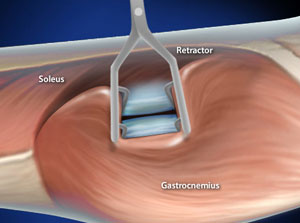 This outpatient procedure is used in the correction of conditions such as flatfoot, chronic Achilles tendonitis, or equinus (commonly called toe walking). Gastrocnemius recession lengthens the muscles and tendons at the back of the leg, allowing the heel to shift downward into a more natural position. In many cases, this technique is performed as an alternative to Percutaneous Tendo-Achilles Lengthening, which can permanently weaken the Achilles tendon.
This outpatient procedure is used in the correction of conditions such as flatfoot, chronic Achilles tendonitis, or equinus (commonly called toe walking). Gastrocnemius recession lengthens the muscles and tendons at the back of the leg, allowing the heel to shift downward into a more natural position. In many cases, this technique is performed as an alternative to Percutaneous Tendo-Achilles Lengthening, which can permanently weaken the Achilles tendon.

